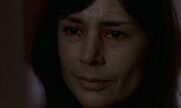"Shouts and Whispers" includes many of Bergman's film elements. In this film, he uses color and composition to the extreme. Whether it is the dizzying blood-red color or the frightening close-up close-up, it reveals a kind of uneasy message, allowing people to enter his thinking deeper and understand his fearful childhood and fearful life. He never liked to reconcile with anyone, even God.
The story of this movie is so simple that it can't even talk about the plot. The three sisters lived in a large medieval house. The second sister, Anne, suffered from uterine cancer and was dying. Her two sisters, Karin and Maria, and servant Anna took turns to take care of her until her death. The seemingly simple plot actually contains great power, as fascinating as the name of this movie. Bergman's movies are different from Hollywood and traditional European movies, and they are also different from the contemporary Tarkovsky and Fellini movies, although they are obsessed with the dream of movies. His film has a rigorous structure and a clear sense of passage, just like the music of Bach that he likes-neat and serious. This simple story is cut into several paragraphs, combined with memories and dreams, to form a movie version of "Sara Bond". In this movie, everyone has a painful past. Even if they were born in a middle-class family, they are not happy. The eldest sister Karin resembles a person from the Bergman family. She is a typical schizophrenic patient—indifferent, serious, punctual, and refusing to be afraid of love. At the same time, she has lost the ability to love. She does not love diplomats who are much older than her. Husband, in order to hurt her husband and herself, she cut her vagina with a broken wine bottle, making it impossible for her husband to have sex with herself. The second sister, Annie, is an unconcerned child. When she was a child, she could not face the indifference and partiality of her mother. Her mother gave her love to her youngest child Maria. This is the shadow of her life, even she is on the verge of death. Sad experience, she tried her best to get love, but always failed. The little girl Maria is the most beautiful one in the movie. She is selfish and slutty, she likes to touch, but she is indifferent at heart. Because of the affair with her lover, her husband tried to commit suicide. She is always expressing her selfless love, and she likes to pretend to be a loving, Virgin Mary-like person. When Annie died, she hid her face and cried, but she was not close to her dead sister. It was just out of fear of death. , Not from love. There is also an important character Anna. Bergman prefers the name "Anna". In his movie, Anna is the incarnation of the Virgin. The poor servant Anna is the real Virgin in this movie. She carefully takes care of the dying Anne and patiently listens to her pain. Even though she is dead, when the soul comes back to find comfort, she still does not forget to open her chest and let her She felt warm when she died.
There are many films about "red", and many directors prefer this bright color. Kieslowski used red to express fraternity; red in "Ben Ji Farewell" shows a strong, brave and always fighting Frida; Antonioni's "Red Desert" is full of eyeballs of red; The sharp glance of red in Schindler's List warmed the hearts of people in perplexity, fear and despair. "Red" is the main hue of "Shouting and Whispers". This red is different from the red mentioned above and in many movies in history. It is a bright red, blood-like color, which is shocking. The whole movie is filled with death-rich blood red. The clothes of the protagonist, the carpets and ornaments of the room, the color of the wallpaper, and the color of Anne's quilt are all full of red. In this movie, red shows death. When the film initially presented the obscure external space of the house with ulterior motives, entering our field of vision is an "internal space" filled with dark or light red. It is not only the internal space in the sense of space, but also the "internal space" of the protagonist's psychology. ", and the shade of red is also used as an indicator to clearly mark the degree of "sickness" erosion of the character: the dying person is accompanied by a bright red sheet, and her sisters are wrapped in light red pajamas. This is life and death. The slight difference between. Of course, red carpets, red curtains, red walls, red floors, and red furniture jointly construct a metaphorical pathological space that is isomorphic with a heart that is about to die due to inemotional maintenance. In this space, the characters are always emotionally accompanied by red. But each kind of red has its own differences. For example, the big red pajamas worn by Maria when she had an affair with the doctor, showed Maria's sexual desire. The red blood when Maria's husband committed suicide and Karin self-inflicted himself, showing death, bloodthirsty and diaphragm.
Bergman prefers medium and close shots, which is one of the reasons why he was so obsessed with television production in his later years. He likes to place the camera very close to the actor so that he can shoot the expression of the actor so close. In his "Marriage Scene", he explained his understanding of these two scenes throughout. Annie in the film suffers tremendous pain. This pain comes from the body-she is in the advanced stage of uterine cancer and suffers from pain every moment. No one can replace this pain, so she shouts in the film "Who will help me" is also in vain. This kind of pain also comes from the heart-she is still single in middle age, no one can care for her selflessly, she is eager to find someone to talk to, even at the last moment of her life, when the doctor arrives, she is tight. Holding the doctor's hand tightly and placing it on her chest, there is no eroticism in this scene, it is just a kind of depression and pain. Every time her painful illness occurred, Bergman would freeze it with a slow close-up, truly restoring Annie's pain. But when Annie died, a long shot kept her stiff and cold. Nothing was more helpless and scary than this kind of death. The characters in the film live in a wide medieval house, far away from each other, taking care of Annie-her two sisters think this is a responsibility that is difficult to shirk. They are full of complaints and complaints, and even hope. She can die as soon as possible, so at the beginning of this film, we saw Anne lying on the bed, and on the other side of the room was her sleeping little sister Maria. And when Annie was about to be taken by the god of death, she shouted hopelessly, but her sister was still standing by the door, far away from her. But in the end, Bergman gave the audience a touch of warmth, and the three very separated sisters sat together again on a white swing. The Anna in the film is the incarnation of the Virgin in Bergman's heart. When she opens her chest and embraces the dead Anne in her arms, she looks like Michelangelo's sculpture "Our Lady Mourning Christ".
The characters in the film have no happiness in their lives. The abundance of material can't cover up the emptiness in their hearts, nor can they narrow the distance between people. They all live in a cold, just like the weather in Sweden in winter— -Extremely cold, long night. Karin, who suffers from affective phobia, gradually opened her closed heart during the conversation with her younger sister Maria, and showed a trace of tenderness when they were about to be separated, but her sister’s hypocritical description made her fall in again. Desperate, that conversation was just a momentary emotional expression of Maria, perhaps just a conspiracy. The little sister Maria paranoidly believes that she has all the advantages of a woman. When she stood in front of the mirror confidently showing her beauty to her lover, she was shattered by the doctor’s insightful words. In the end, she Embarrassingly repay his lover with a sneer and the same words. Throughout the movie, temporary reconciliation is also a way of expressing despair. In the end, all hopes are shattered and all hope is returned to the original point.
Bergman liked Bach’s music, and a music critic later said of Bach—his music is the closest to divinity. This kind of music from the Baroque era is neat and serious, allowing people to think deeply about religion and God while tearing down their faces. In many of Bergman's works, he talked about the influence of Bach on his creation. Bach's unaccompanied cello Sara Bond appeared in his films more than once, and even his last film work was named "Sara Bond". This cello solo is melancholic and full of vibrato. In the movie, when Karin and Maria talk to the two, the cello cleverly replaces the voice of people. We can’t hear what they are talking about. Only the cello sounds like weeping. The complaint concealed this seemingly enthusiastic but cold conversation. Whenever Annie started to recall the past, she faced her mother in her memory, and the sad Chopin No. 13 Mazuka would continue to appear. With the constant remembrance, this pain began to melt and return. To the depths of the memory, he was broken by the character's painful status quo. The sound in Bergman's movies is very rich, which reminds me of Tarkovsky's movies, his movies will have the faint noise of a chainsaw and the exotic Taoist music that looks like a natural phenomenon. The trembling bells in the opening of the movie hint at the coldness of time. It walks non-stop, and seems to be lifeless, but in essence, people are controlled by it and will be brought to the depths of the night by it. It also implies that Annie has already There is not much life. Whenever a chapter of the movie ends and the characters are brought out of the picture by a patch of red, the wind bell rings slowly, cold and icy. Music is the key to the success or failure of a movie.
This film, filmed in 1972, has won numerous awards. The three leading female actors-Ingrid Turing, Harriet Anderson, and Liv Ullman are talented, perform well, and have a good grasp of the emotions of the characters. It is also an important factor in the success of the film. As long as the actor is right, the play is half of the success. Although more than 30 years have passed since the film was released, the film is still not outdated. Whether it is in the West or the East, under any system, human emotions and pain are common. Some people call Bergman's movie "The Conscience of Movies", which is not an exaggeration. "Shouting and Whispering" shows his emotions, and he wants to show his depressed childhood, which is a kind of spiritual salvation.
View more about Cries & Whispers reviews











